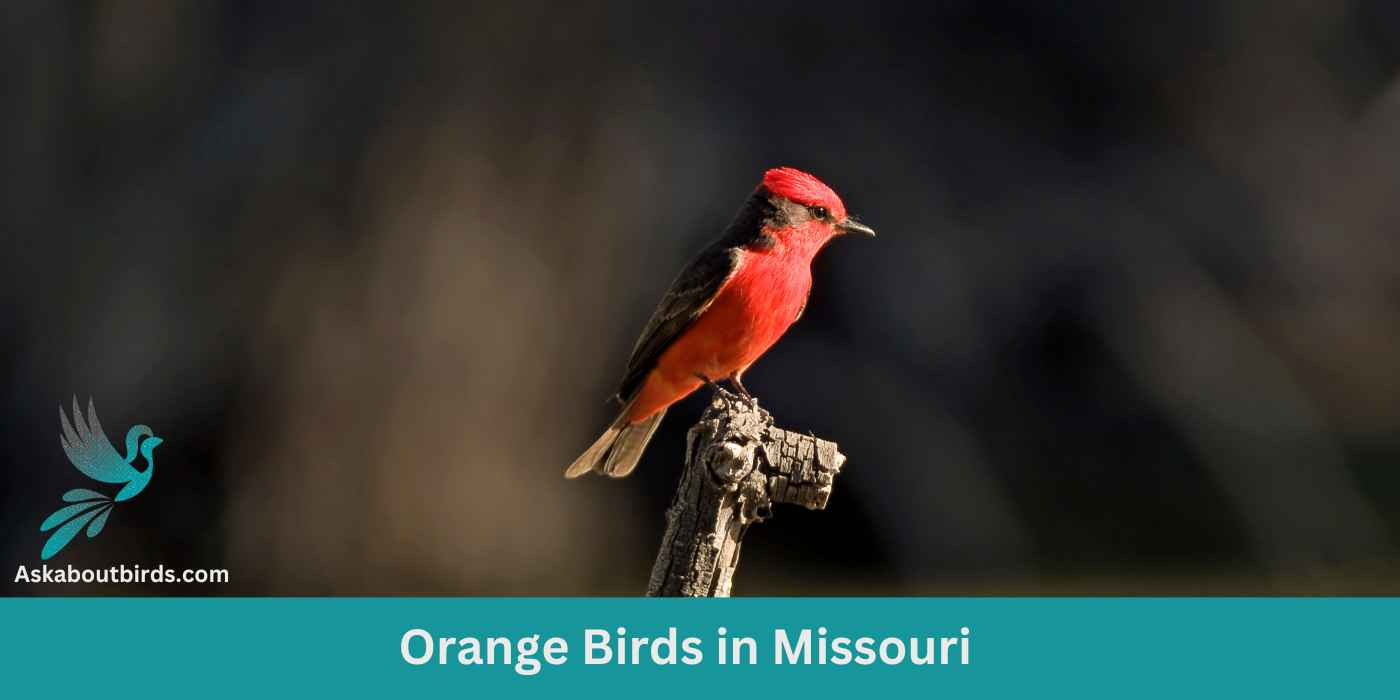From the rolling Ozark Mountains to the vast grasslands of the Great Plains, Missouri’s diverse landscapes provide a vibrant tapestry for bird enthusiasts. Among the myriad of avian wonders, the state boasts a stunning array of orange-hued birds that stand out with their fiery plumages.
Orange Birds Found In Missouri
Missouri’s varied landscapes, from the Ozark Mountains to expansive river valleys, create a haven for a diverse array of bird species. The state has been proactive in its conservation initiatives, preserving critical habitats and ensuring that birds have the necessary resources to flourish.
Baltimore Oriole


| Feature | Measurement |
|---|---|
| Scientific Name | Icterus galbula |
| Length | 6.7–8.7 in |
| Wingspan | 9.1–12.6 in |
| Weight | 22.3-42 g |
The Baltimore Oriole is a stunning bird, best known for its vibrant coloration and its rich, whistling song.
Appearance: The male Baltimore Oriole is notable for his bright orange and black plumage and black and white wing bars, a stark contrast to the more muted yellow-brown coloration of the female. Both sexes, however, have long pointed bills and white bars on their wings.
Diet: Baltimore Orioles have a diverse diet that includes insects, fruits, and nectar. Their preference for sweet juices and fruit pulp often brings them to backyard feeders offering oranges and jelly.
Reproduction: The female Baltimore Oriole is responsible for building the distinctive hanging nest, often woven together from fine materials like hair and grass. These nests are usually high in trees to avoid predators. The female lays 3-7 eggs, which are incubated for about two weeks.
Red-breasted Nuthatch

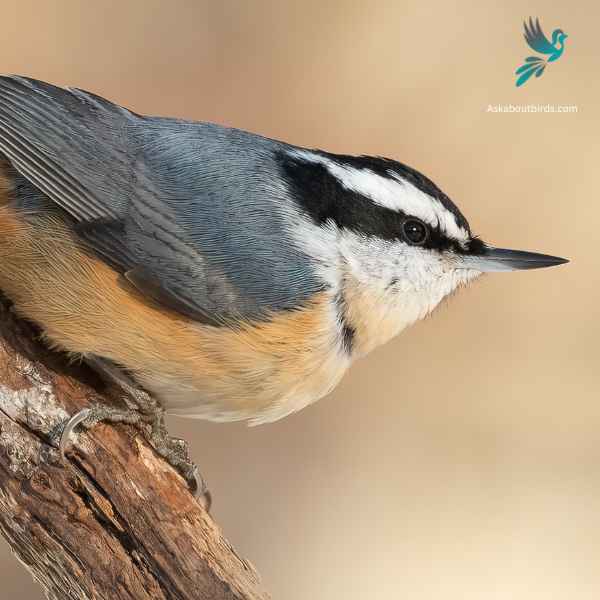
| Feature | Measurement |
|---|---|
| Scientific Name | Sitta canadensis |
| Length | 4.3–4.7 in |
| Wingspan | 8.3 in |
| Weight | 0.3–0.5 oz |
The Red-breasted Nuthatch is a small, agile songbird, known for its ability to move headfirst down tree trunks while searching for food.
Appearance: This bird boasts a slate-blue back and a pale rust-red underside. A prominent black stripe runs through the eye and is bordered above by a white eyebrow. Their sharp, pointed bill is characteristic of the species.
Diet: Red-breasted Nuthatches primarily feed on insects and seeds, especially those from coniferous trees. They have a fondness for large seeds, which they wedge into bark crevices to hack open with their bills.
Reproduction: These birds construct nests in natural tree cavities or abandoned woodpecker holes, often lining the entrance with resin. This is thought to deter predators or competitors from entering. The female typically lays a clutch of 5 to 6 eggs, and both parents partake in feeding the chicks once they hatch.
Orchard Oriole
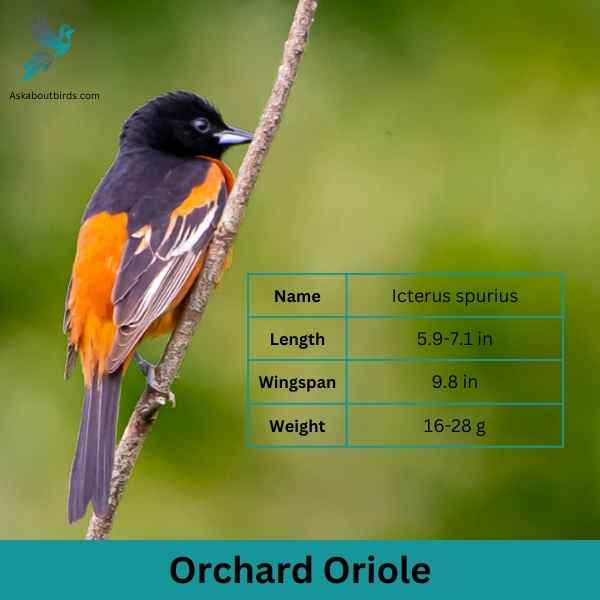
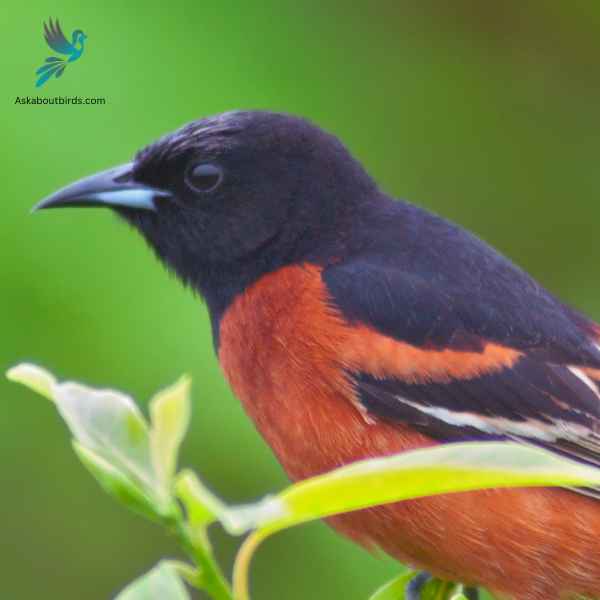
| Feature | Measurement |
|---|---|
| Scientific Name | Icterus spurius |
| Length | 5.9-7.1 in |
| Wingspan | 9.8 in |
| Weight | 16-28 g |
The Orchard Oriole is a small songbird noted for its distinctive coloration and melodic song.
Appearance: Male Orchard Orioles are a striking sight with their dark chestnut body and black head and black and white wings, while females and immature males are olive-green and feature a yellowish underpart. The species is often recognized by its slender body and pointed bill.
Diet: The diet of the Orchard Oriole consists primarily of insects, fruits, and nectar. They are adept at catching insects mid-air and are also known to sip nectar from flowers, aiding in pollination. When fruits are in season, they make up a substantial portion of the bird’s diet.
Reproduction: Orchard Orioles often nest in open woodlands and orchards, hence their name. The female is responsible for building the nest, typically choosing a location in a tree or shrub. The female lays a clutch of 4 to 6 eggs, which she incubates for about two weeks.
Scarlet Tanager


| Feature | Measurement |
|---|---|
| Scientific Name | Piranga olivacea |
| Length | 6.3 to 7.5 in |
| Wingspan | 9.8 to 11.8 in |
| Weight | 23.5 to 38 g |
The Scarlet Tanager is a strikingly colorful bird known for its brilliant plumage and distinctive song.
Appearance: Male Scarlet Tanagers are notable for their vibrant scarlet bodies contrasted with black wings and tail, making them one of the most intensely colored birds. Females and juveniles, on the other hand, have a subdued olive-yellow body color with darker wings and tail.
Diet: The diet of the Scarlet Tanager is largely made up of insects, including beetles, cicadas, aphids, and others. They are adept flycatchers, seizing insects in mid-air or picking them off foliage. They also consume fruits and berries, especially during migration and in their winter habitats.
Reproduction: The female Scarlet Tanager builds a cup-shaped nest using twigs, rootlets, and grass, typically well-hidden in the dense foliage of trees. She lays 3 to 5 eggs and incubates them for about two weeks.
American Redstart


| Feature | Measurement |
|---|---|
| Scientific Name | Setophaga ruticilla |
| Length | 4.3 to 5.5 in |
| Wingspan | 6.3 to 9.1 in |
| Weight | 8.6 g |
The American Redstart is a lively warbler known for its vivid colors and active hunting style, often seen flitting about, fanning its tail to startle and catch insects.
Appearance: Adult male American Redstarts boast striking black plumage with bright orange patches on the sides, wings, and tail. Females and immature males have grayish-olive upperparts with yellow patches in the same areas where the males display orange.
Diet: American Redstarts are primarily insectivores. They actively forage for flying insects, as well as caterpillars and spiders, often using their colorful tails to startle prey and make them easier to catch.
Reproduction: The female American Redstart builds a cup-shaped nest in the fork of a tree branch. Typically, she lays a clutch of 3 to 5 eggs. The female takes on the primary responsibility of incubating the eggs, while both parents participate in feeding the fledglings after they hatch.
Eastern Towhee

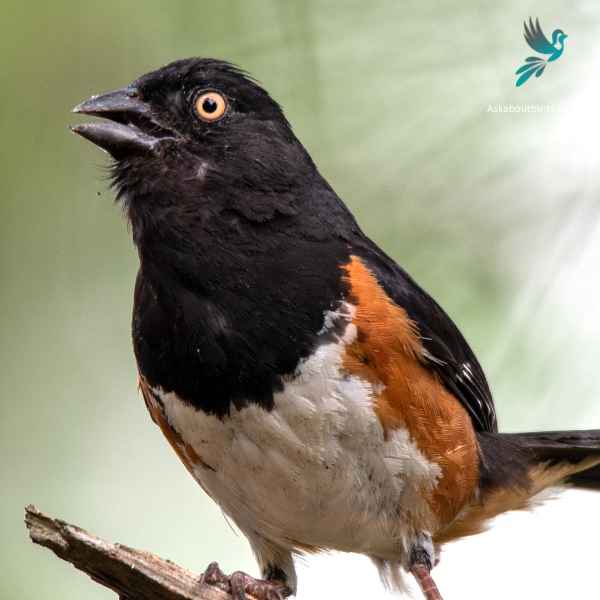
| Feature | Measurement |
|---|---|
| Scientific Name | Pipilo erythrophthalmus |
| Length | 6.8 to 9.1 in |
| Wingspan | 7.9–11.8 in |
| Weight | 32 to 53 g |
The Eastern Towhee is a distinctive songbird known for its unique calls and eye-catching coloration.
Appearance: Male Eastern Towhees are characterized by a striking combination of a black head, back and tail, contrasting with a white belly and rufous flanks. Females sport similar patterns but instead of black, they have a rich brown color. Both genders have red eyes, lending a special charm to their overall appearance.
Diet: Eastern Towhees primarily feed on a variety of insects, seeds, and berries. Their diet is quite diverse, taking advantage of seasonal offerings, which includes beetles, caterpillars, spiders, acorns, grass seeds, and various fruits and berries.
Reproduction: Eastern Towhees build their nests on or near the ground, often in a shrub or a small tree. The female lays around 3-5 eggs and takes the primary role in incubating them over about 12-13 days.
Northern Flicker

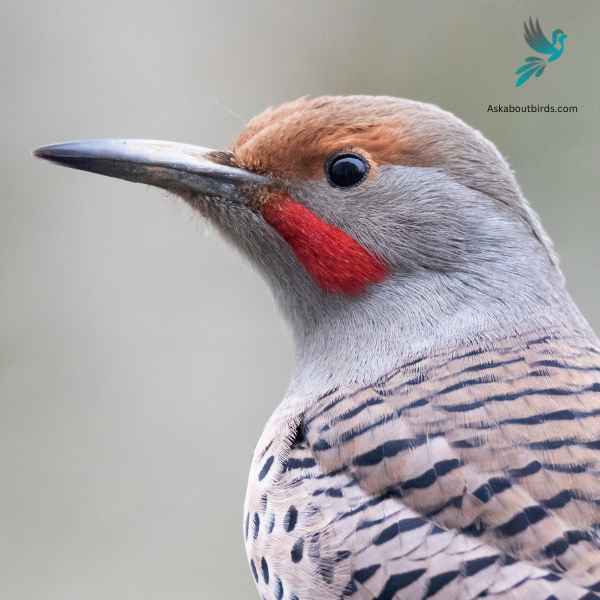
| Feature | Measurement |
|---|---|
| Scientific Name | Colaptes auratus |
| Length | 11–12 in |
| Wingspan | 17–20 in |
| Weight | 3.9–5.6 oz |
The Northern Flicker is a medium-sized woodpecker, recognized by its unique patterns and coloring, often found drumming on trees or foraging on the ground across North America.
Appearance: The Northern Flicker stands out with its grayish brown body, black-scalloped plumage, and a black bib. Males sport a distinctive black or red mustache stripe. Depending on the subspecies, the underwing and undertail feathers can be bright yellow or red, flashing vividly during flight.
Diet: While most woodpeckers are tree-bark foragers, the Northern Flicker prefers hunting on the ground. Its primary diet consists of ants and beetles, supplemented occasionally by fruits, berries, seeds, and other small insects.
Reproduction: Northern Flickers are cavity nesters, preferring to excavate their nesting hole in dead or diseased tree trunks. The interior of the nest is lined with wood chips.
Summer Tanager


| Feature | Measurement |
|---|---|
| Scientific Name | Piranga rubra |
| Length | 6.7 in |
| Wingspan | 28 to 30 cm |
| Weight | 29 g |
The Summer Tanager is a medium-sized songbird admired for its radiant plumage and melodious song.
Appearance: Male Summer Tanagers are an impressive bright red, while females and juveniles present a softer, yellow-orange color. Both genders have a large, slightly hooked bill and relatively short tail.
Diet: Summer Tanagers primarily feed on insects, including bees and wasps, which they catch in flight or pick off vegetation. They are also known to eat fruits and berries, making them helpful in controlling pest populations and seed dispersal.
Reproduction: The female Summer Tanager builds a loose, shallow cup-shaped nest out of twigs and grass, usually hidden in the foliage of trees. The female typically lays 3-5 eggs, which she will incubate for about two weeks.
Vermilion Flycatcher
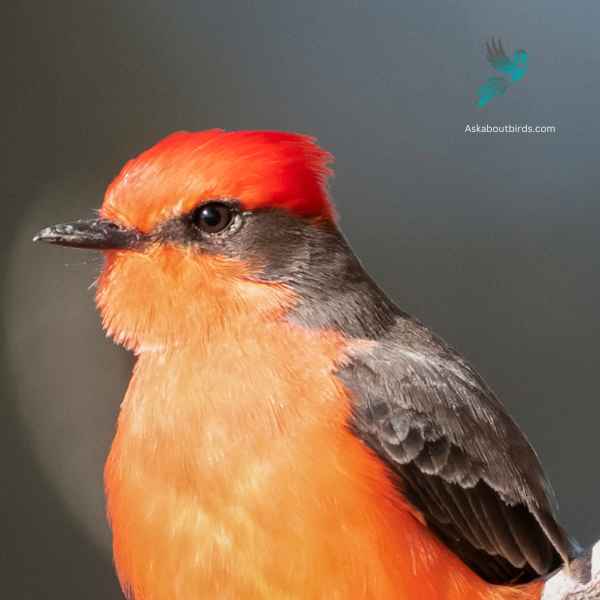

| Feature | Measurement |
|---|---|
| Scientific Name | Pyrocephalus obscurus |
| Length | 5.1–5.5 in |
| Wingspan | 9.4 to 9.8 in |
| Weight | 11 to 14 g |
The Vermilion Flycatcher is a small and colorful bird native to the Americas. The male Vermilion Flycatcher is a striking sight, displaying a vibrant red plumage on its head, breast, and underparts, contrasting with its brown wings and black tail below. Females, on the other hand, have more muted colors, featuring a pale yellowish belly and grayish-brown upperparts.
Vermilion Flycatchers are known for their lively and acrobatic flight displays, which they perform during courtship or to defend their territories. They often sing a series of soft, whistled notes while engaged in these aerial displays. They construct cup-shaped nests, usually in shrubs or low trees, where females lay their eggs and raise their young.
Barn Swallow

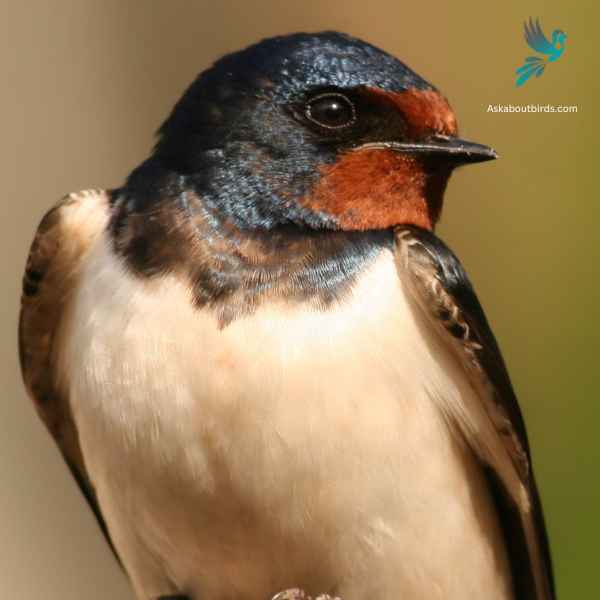
| Feature | Measurement |
|---|---|
| Scientific Name | Hirundo rustica |
| Length | 6.5–7.5 in |
| Wingspan | 12.5–13.5 in |
| Weight | 16–22 g |
The Barn Swallow is a sleek, agile bird renowned for its graceful flight patterns and iconic forked tail, often seen darting over fields and water bodies in search of flying insects.
Appearance: Barn Swallows have deep blue, almost iridescent, upperparts and a rufous to tawny underbelly. Their distinctively forked tail and long wings give them a streamlined look. Both males and females have a similar appearance, though males often exhibit slightly brighter colors and a deeper fork in the tail.
Diet: Barn Swallows feed primarily on flying insects, which they catch in mid-air during their agile and acrobatic flights. Their diet includes flies, beetles, moths, and other small flying insects.
Reproduction: Barn Swallows are known for building their mud nests on man-made structures, particularly barns, bridges, and eaves. The nest is cup-shaped and made from mud pellets, often lined with feathers. The female lays a clutch of 4 to 6 eggs.
American Robins


| Feature | Measurement |
|---|---|
| Scientific Name | Leptotila plumbeicep |
| Length | 10.6-11.8 in |
| Wingspan | — |
| Weight | 160-200 g |
The American Robin is a widely recognized bird species known for its melodious song and early bird tendencies.
Appearance: American Robins are medium-sized birds with a distinctive appearance. Both males and females sport a gray to brown back and a warm red to orange breast and belly and gray wings. They also have a characteristic white eye-ring and a black head, but males are usually darker than females.
Diet: American Robins have a diverse diet that changes depending on the season. In summer, they feed heavily on earthworms, beetles, and other invertebrates, which they catch on the ground. During winter, they mostly eat fruits and berries.
Reproduction: American Robins usually build their nests in trees or shrubs, but they are also known to nest on human-made structures. The female lays a clutch of about 3 to 5 eggs, which she incubates for about 12 to 14 days.
Where to Spot Missouri’s Orange Birds
Missouri’s landscapes, from its flowing rivers to its lush forests, have long been a haven for bird enthusiasts. The state’s varied ecosystems are perfect spots to catch a glimpse of a vibrant array of avian species, especially those with a burst of orange in their plumage. Here are some of the top locations in Missouri known for their bird-watching allure:
- Mingo National Wildlife Refuge, Puxico: A pristine sanctuary for migratory waterfowl, this refuge offers more than 21,000 acres of bottomland hardwood forests and wetlands. Bird enthusiasts can witness the radiant Baltimore Orioles and Prothonotary Warblers amidst a plethora of other species.
- Mark Twain National Forest: This vast forest stretches over 1.5 million acres, encompassing woodlands, streams, and grasslands. Here, the mixed habitats invite birds like the American Redstart and Scarlet Tanagers to nest and feed.
- Eagle Bluffs Conservation Area, Columbia: Overlooking the Missouri River, this location is known for its diverse bird population, especially during migration seasons. Apart from the common wetland birds, one can often spot Orchard Orioles and Red-headed Woodpeckers.
- Busch Conservation Area, St. Charles: With a mix of forests, grasslands, and wetlands, this conservation area is a hotspot for bird watching. During spring and summer, the melodies of the Eastern Towhee and Northern Flicker often fill the air.
- Loess Bluffs National Wildlife Refuge, Forest City: Originally established for snow geese and other migratory birds, the refuge’s varied habitats cater to a wide range of bird species. The wooded areas are especially good for spotting Summer Tanagers and other woodland birds.
| State’s Orange Birds | Best Spots to See Orange Birds |
|---|---|
| Iowa’s Orange Birds | Neal Smith NWR, Saylorville Lake, Ledges State Park |
| Illinois’s Orange Birds | Montrose Point Bird Sanctuary, Starved Rock State Park, Cache River Wetlands |
| Kentucky’s Orange Birds | Mammoth Cave National Park, . Red River Gorge, Land Between the Lakes |
| Tennessee’s Orange Birds | Great Smoky Mountains National Park, Radnor Lake State Park, Reelfoot Lake |
| Arkansas’s Orange Birds | Hot Springs National Park, Buffalo National River, Ouachita National Forest |
| Oklahoma’s Orange Birds | Wichita Mountains Wildlife Refuge, Beaver’s Bend State Park, Oxley Nature Center |
| Kansas’s Orange Birds | Quivira National Wildlife Refuge, Cheyenne Bottoms, Tallgrass Prairie National Preserve |
| Nebraska’s Orange Birds | Fort Niobrara National Wildlife Refuge, Crescent Lake NWR, Rowes Sanctuary |
FAQs on Orange Bird Species Found in Missouri
Which orange birds commonly visit bird feeders in Missouri?
Missouri bird feeders frequently welcome birds with bright orange plumage. The Eastern Bluebird, known scientifically as Sialia sialis, stands out with its vibrant orange chest and contrasting blue wings. Northern Cardinals, another common backyard bird, display a reddish-brown hue and are known to visit feeders, especially those stocked with black oil sunflower seeds.
What types of feed attract bright orange and yellow birds in Missouri backyards?
To attract the orange and yellow birds of Missouri, such as the Eastern Bluebird and Yellow-throated Vireo (known for their bright yellow throats) typically eat seeds, homeowners can fill their bird feeders with black oil sunflower seeds, a favorite among many wild birds. For other birds like orioles, oriole feeders filled with nectar, grape jelly, or orange slices can be effective. Additionally, platform feeders stocked with seeds might draw in yellow birds like Yellow-rumped Warblers and Yellow-throated Vireos.
Are there any other distinctive birds seen in Missouri?
Absolutely! Apart from the bright orange birds, Missouri is home to a myriad of colorful avian species. Bright red birds like the Red-winged Blackbird, gray birds with dark gray heads like the Blue Jays, and even greenish-yellow birds such as the Yellow-throated Vireo are frequent visitors. Purple Finches, displaying a mix of reddish and brownish-gray hues, can also be spotted in some areas, primarily around forest edges and tall trees.

